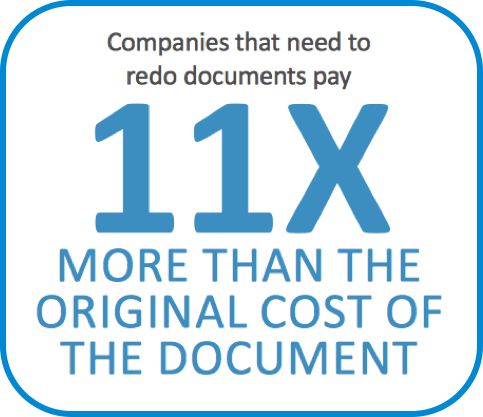Content Stored in One Central Location
Presentation management allows employees to find all of the files they need in one central location.
All presentations, video, audio and other documents are stored in a place that’s familiar and known to every employee. This way, everyone on your team can access them easily—from anywhere inside or outside of the corporate network. There’s no bouncing around from drive to drive and folder to folder in an endless search for the files you need to do your job.
A PWC study found that 7.5% of documents get lost and 3% get misfiled—meaning that, right off the bat, when you don’t have a presentation management strategy in place, more than 10% of the files your team creates are never used.

AIIM: Records Management Strategies
There are several different ways to organize your content: by product, by division, by discipline, by user group and so on. It makes sense to organize and segment content however your business is divided.
Presentation management solutions ensure that only your best, compliant assets are shared with proper audiences. Everyone is confident that they are delivering the right message; they don’t have to worry about whether they’re relying on garbage slides.
The first and most important step in your presentation management strategy is providing a library of compliant slides that have the requisite approvals from legal, regulatory, marketing and sales. This makes it easy for everyone on the team to access the content they need.
While it may take some time to get your content house in order to begin with, the investment will definitely be worthwhile. Once everything is sorted and organized, it’s easy to maintain.

To start a widespread organization project, break it down into smaller, manageable tasks like:
-
Formatting PowerPoint templates. Make sure everyone is using the right logo, color guidelines, graphics and fonts on properly formatted Slide Masters.
-
Organizing content. Once you have your decks together, assign obvious and consistent file names and tags so they are easy to identify.
-
Creating mini-decks. These smaller decks will likely be used many times in many meetings. Generally speaking, they will feature your company’s history, its values, information about your products and services, promotional content, proprietary research, case studies, executive biographies and more. The idea here is to provide presentation content in smaller modules so salespeople can select their topics and then easily find cohesive, logical presentations for them. This kind of content probably already exists somewhere on your network—maybe even hidden in bigger decks. And there’s probably a lot of it—which means you need to prioritize. Start with the most important information, like product-specific data that your sales team will use most often. Once you have this content locked down, build out the other modules.

Presentation management evolves with your business. You can add and remove content as you go; there’s no start or end date.
The bottom line is that—with a presentation management strategy in place—all of your relevant assets will be stored in one central location. As a result, your organization becomes more agile and more effective. Everyone knows where everything is, and when they don’t they can search and find it easily. All that time previously spent searching for certain files is reclaimed—which increases productivity across the organization.
